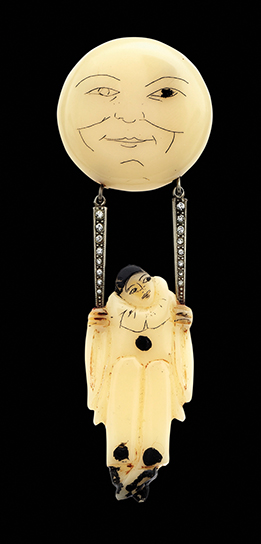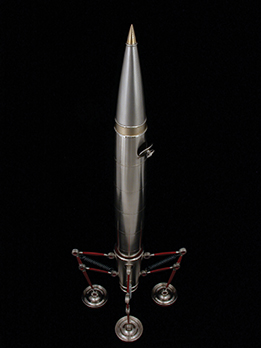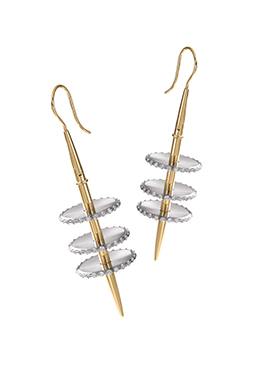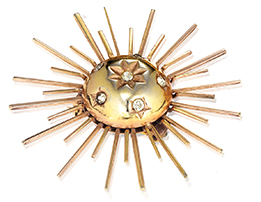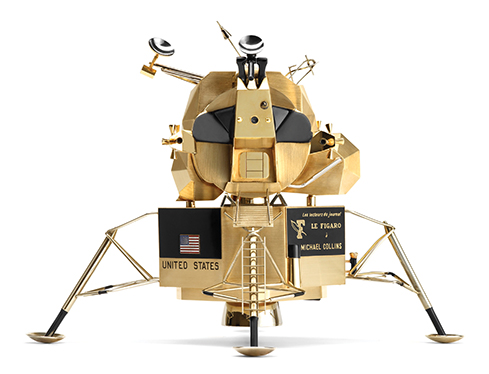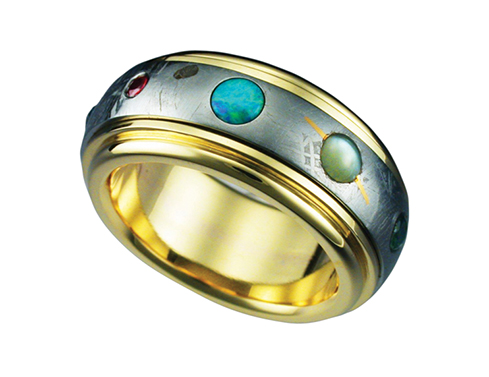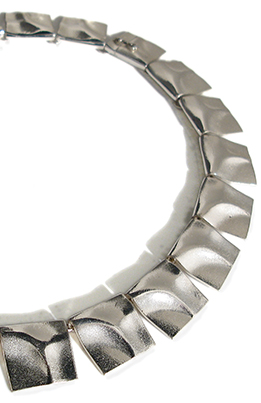 |
||||||||||||||||||||
Above: Comet brooches were popular throughout the 19th century and early to mid-20th century. This example is from the 1960s. |
Cosmic Bling
In a stunning display at Carnegie Museum of Natural History, the wonder and beauty of space meets one of the world’s oldest traditions, jewelry making. When scientists made international headlines in 2012 upon discovering a distant, diamond-rich planet twice the size of Earth, Elyse Zorn Karlin took notice. The flashy finding got the jewelry historian thinking: For as far back as she could remember (and then some), space had been a muse for human adornment. Over the next year, Zorn Karlin ran with this idea, building a first-of-its-kind showcase of wearable and decorative arts that melds scientific exploration with popular culture, capturing humankind’s fascination with all things celestial.
In addition to jewelry inspired by the moon, stars, and planets, Out of This World also includes wearable art fashioned from materials created during the space race— think titanium, polymer, and fiber optic glass—and, most surprising, jewelry made with actual materials from space, including meteorites. In fact, when pallasite—an increasingly rare meteorite—is cut into thin slices and polished, the semiprecious gem peridot forms translucent pieces reminiscent of the stained glass windows of a church. These themes are all topics in Zorn Karlin’s ever-growing orbit: after all, her partner is a retired space engineer. “Having conversations with him about the show certainly helped,” she says. Featuring work from more than 100 designers, luxury brands, collectors, and even a few astronauts, there are two clear showstoppers: The Tampa Necklace by Van Cleef and Arpels, a one-of-a-kind design featuring a rocket and a trail of diamonds inspired by Jules Verne’s novel From the Earth to the Moon; and a solid, 18-carat-gold Cartier model of the 1969 Apollo 11 lunar module. Because of its stunning detached and interchangeable parts, the necklace can be worn nine ways, and includes white and yellow gold with round, baguette, and rose-cut diamonds; pink, purple, and yellow sapphires; and orange garnet. “It’s one of those pieces you never forget,” says Zorn Karlin, an independent curator and editor-in-chief of Adornment, The Magazine of Jewelry and Related Arts.
The rare and incredibly valuable NASA keepsake— one of only three in existence—came to be thanks to readers of the French newspaper Le Figaro, who pitched in to commission the trio of precious replicas for the three moon-walking astronauts: Neil Armstrong, Buzz Aldrin, and Michael Collins. The replica in the show was once owned by Collins. Jewelry, says Zorn Karlin, is a revealing window into the past. “Studying jewelry is a really fun way to read history.”
ONE GIANT STEPWhen the Space Age blasted off, pop culture followed, and the exhibition has the 1960s costume jewelry to prove it. “A lot of it is very abstract, and suddenly it dawned on me that much of it was patterned after Sputnik,” says Zorn Karlin, referencing the Soviet probe that became the first manmade object to reach space, launching a Cold War race to the moon. Charm bracelets with space themes were also all the rage. The Apollo program, born of President John F. Kennedy’s commitment in 1961 to putting America on the moon before the end of the decade, sparked innovation as well as an all-out space obsession. It influenced everything from fashion to furniture, children’s toys, and medicine. The technology that powers ear thermometers, for example, was developed to monitor the temperature of the stars. And we can thank NASA’s preparation for the Apollo mission for memory foam (used to cushion aircraft seats), domestic water filters, and the advent of cordless tools (needed in order to take samples from the moon). Nearly a half century later, America’s love affair with that era is hardly over. Astronaut Wives Club, an upcoming ABC miniseries, will focus on the women behind the men of the Mercury, Gemini, and Apollo programs that took America to the moon and back. Apollo gave the world, still reeling in the wake of two world wars, the courage to dream about tomorrow.
“Studying jewelry is a really fun way to read history.”
Exhibition Curator Elyse Zorn KarlinIt also gave its astronauts the perk of taking as many as 20 personal items on space missions. As the exhibition explains, jewelry is often among their stash because it’s compact and personal. Some jewelry is created especially for space walkers, including one watch crafted for the Jet Propulsion Laboratory that tells Mars time. Once an object has flown in space—such as John Biagotti’s Nine Planet Ring set with nine gemstones representing each of our Solar System’s planets (made before Pluto was downgraded to a dwarf planet)—its value spikes. What makes Biagotti’s design, worn by astronauts on the International Space Station in 2011, so special? The band of meteorite spins independently of the gold ring so the planets rotate around the wearer’s finger. “I always wanted to send a meteorite back to space,” says Biagotti.
SPACE GEMSTitanium, used in spacecraft because it’s lightweight and durable, has become increasingly popular with jewelers for the same reasons. Another industry trend catching fire: fashioning one-of-a-kind creations from materials that come directly from outer space, including meteorites, pallasite, and tektite—natural glass that many scientists believe is formed when extraterrestrial matter hits earth, forming a crater and forcing debris out of the earth; the intense heat turns the molten material to glass.A colorful, over-the-top, gorgeous example: a ring dubbed Kitchen Sink by John Hatleberg, a conceptual gem artist known for his exact replicas of famous diamonds, including The Hope Diamond. As its name implies, Kitchen Sink, another star of Out of This World, boasts an overabundance of cosmic bling: pallasite, white diamond, red emerald, and sapphire.
For Zorn Karlin, it’s this kind of present-day jewelry making that turned out to be among the most fascinating. “It surprised me just how many jewelers are influenced by space today,” she says. “Some of the work is true representations and some is more abstract. But they’re all still looking to the skies for inspiration.” Out of This World! Jewelry in the Space Age was originated by the Association for the Study of Jewelry & Related Arts, LLC, with Elyse Zorn Karlin as consulting curator, and Eric J. Hoffman as the space consultant. Support for the exhibition is provided by Schneider Downs and Burns White.
|
|||||||||||||||||||
Saving the Songbird · Before They Were Famous · Visually Telling · Special Section: A Tribute to Our Donors · President's Note · NewsWorthy · Face Time: Cecile Shellman · Artistic License: Born to Paint · Science & Nature: Making It Count · Travel Log · The Big Picture
 |
Copyright © 2017 CARNEGIE Magazine. All rights reserved. |

